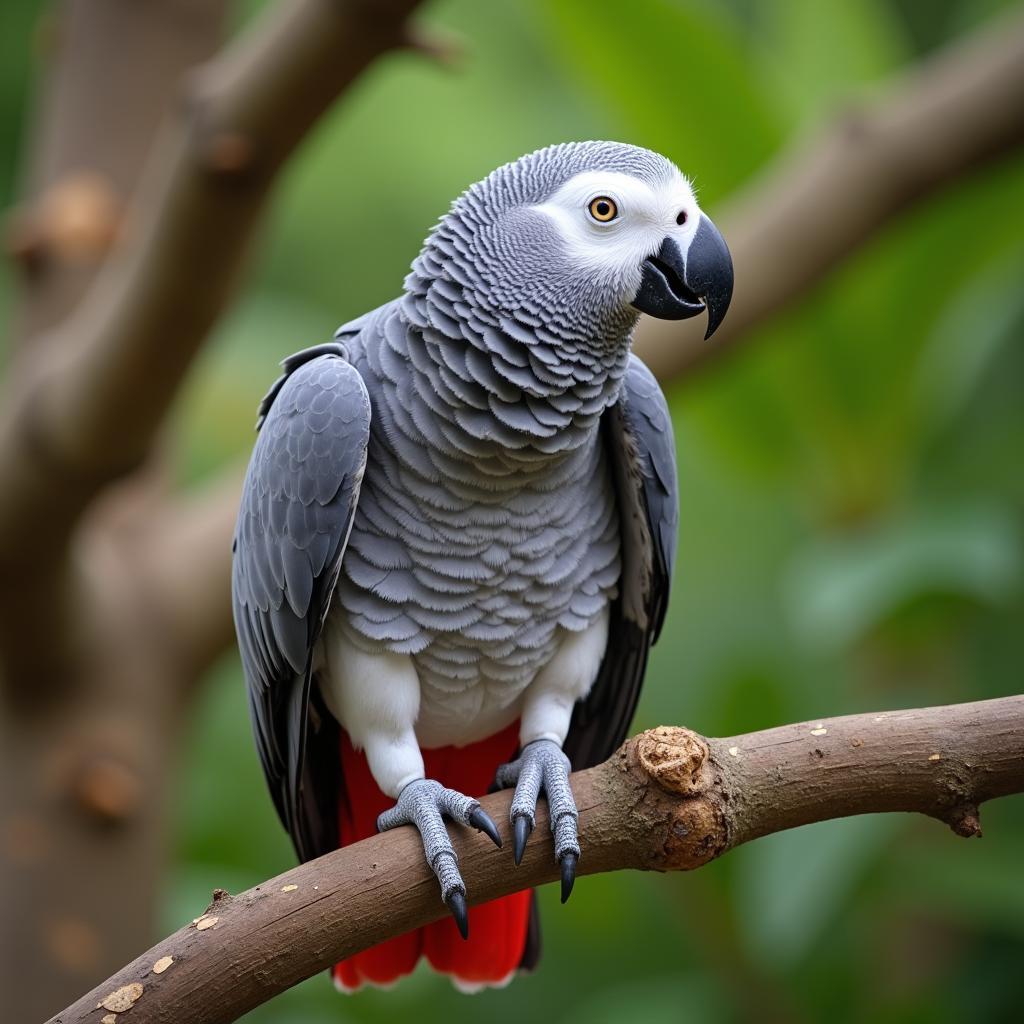The African Grey with White Toes: Myth or Reality?
The African grey parrot, renowned for its intelligence and talking abilities, is a popular companion bird. But what about an African Grey With White Toes? This intriguing characteristic sparks curiosity and raises questions among bird enthusiasts. We’ll delve into the genetics, potential causes, and significance of white toes in African greys, exploring the science and dispelling any myths surrounding this unique trait.
Understanding African Grey Parrot Toe Coloration
Typically, African grey parrots have dark gray toes, complementing their overall plumage. However, variations in toe color can occur, ranging from lighter shades of gray to, in rare instances, white. Is this a sign of a different subspecies, a health issue, or simply a genetic anomaly? Let’s investigate the possibilities. One factor influencing toe color is age. Younger African greys african children could have eaten sometimes exhibit lighter toe coloration, which may darken as they mature. This is due to the gradual deposition of melanin, the pigment responsible for color in skin, feathers, and other tissues.
Genetics and the African Grey with White Toes
Genetics play a significant role in determining an African grey’s physical characteristics, including toe color. Just as with eye color in humans, variations can arise due to different combinations of genes. While the specific genes responsible for toe color in African greys haven’t been fully identified, it’s likely that a recessive gene or a combination of genes could lead to the expression of white toes. This doesn’t necessarily indicate a health problem or a different subspecies, but rather a natural variation within the species. It’s similar to how some people have freckles and others don’t – it’s just a different expression of their genetic makeup.
Is it a Health Concern? Addressing Common Worries
Naturally, any deviation from the norm can raise concerns about a bird’s health. However, white toes in African greys are not typically indicative of a health problem. Unless accompanied by other symptoms like swelling, lesions, or difficulty perching, white toes are generally considered a benign cosmetic variation. It’s crucial to remember that individual birds can exhibit unique traits, and this diversity is part of what makes them so fascinating.
 A Healthy African Grey with White Toes Perched on a Branch
A Healthy African Grey with White Toes Perched on a Branch
Diet and Environmental Factors: Do They Play a Role?
While genetics are the primary driver of toe color, some speculate that diet and environmental factors could potentially influence pigmentation. However, there’s no conclusive scientific evidence to support this claim. Maintaining a balanced diet and a healthy environment is essential for an African grey’s overall well-being, but it’s unlikely to directly affect toe color. You can find more information about African birds on african birds wiki.
Identifying an African Grey Subspecies: Beyond Toe Color
Differentiating between African grey subspecies, such as the Congo African grey and the Timneh African grey, involves more than just looking at toe color. Size, tail feather coloration, and beak shape are key factors in subspecies identification. While toe color can vary within each subspecies, it’s not a reliable indicator on its own.
What does it mean if my African Grey has white toes?
As discussed, white toes in African greys are usually a harmless genetic variation.
Are African Greys with white toes rare?
While not extremely common, they are also not exceptionally rare. It’s a naturally occurring variation within the species.
Should I be concerned about my African Grey’s white toes?
Not unless accompanied by other symptoms like swelling or lesions.
Can diet change the color of my African Grey’s toes?
There’s no scientific evidence to support this.
How can I tell what subspecies my African Grey is?
Consult an avian veterinarian or an experienced breeder for accurate subspecies identification based on multiple factors, not just toe color.
The Beauty of Variation in African Greys
Ultimately, whether an African grey has dark gray or white toes doesn’t diminish its intelligence, charm, or ability to be a wonderful companion. These variations are simply a testament to the natural diversity within the species. Embracing these differences is part of appreciating the unique beauty of each individual bird.
In conclusion, the African grey with white toes remains a topic of fascination. While genetics play the most significant role in this unique trait, other factors may contribute. The key takeaway is that white toes, in most cases, are simply a natural variation and not a cause for concern.
FAQ
What causes white toes in African Greys?
Genetics are the primary cause.
Are white toes a sign of illness?
Usually not, unless accompanied by other symptoms.
Do all African Greys have dark grey toes?
No, toe color can vary.
Can environmental factors affect toe color?
There’s no scientific evidence to confirm this.
Is toe color important for subspecies identification?
No, other factors are more reliable.
Are African Greys with white toes valuable?
Their value is comparable to other African Greys, as toe color doesn’t significantly impact their overall worth.
Where can I learn more about African Grey parrot care?
Consult reputable avian veterinarians, breeders, and online resources dedicated to parrot care.
Do you have any other questions about your African Grey? Check out our other articles on african children could have eaten for more insights.
For further assistance or inquiries, please don’t hesitate to contact us. Call: +255768904061, Email: kaka.mag@gmail.com, or visit us at: Mbarali DC Mawindi, Kangaga, Tanzania. Our customer support team is available 24/7.
